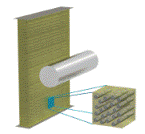Mechanical and Materials Engineering, Department of

Department of Engineering Mechanics: Dissertations, Theses, and Student Research
Date of this Version
Winter 12-9-2011
Document Type
Thesis
Abstract
We look at generic strategies to transfer material grading into finite element methods. Three strategies are proposed to transfer material grading into the finite element analysis. These strategies are node-centered, element-centered, and the definition of material grading through external functions. The process to achieve each strategy is stated, and examples are used to illustrate each strategy, and to compare them. The strategies are implemented in finite-deformation nonlinear elastic analysis.
Several examples are used to illustrate the implementation of each strategy for graded isotropic materials. For these examples, the results obtained from finite element models are compared with those obtained from classical beam theory to verify the finite element implementation. For graded anisotropic materials, a general finite deformation model for stress is developed and implemented. This model can take account of material grading both in material parameters and direction of the anisotropy. Several examples of graded anisotropic materials are analyzed to verify implementation of the model and compare proposed strategies.
The analysis of the different strategies indicates that when comparing the needed memory, speed, and implementation, new strategies that are based on flexible FEM may provide advantage in solving problems with material grading.
Advisor: Mehrdad Negahban
Included in
Engineering Mechanics Commons, Mechanical Engineering Commons, Mechanics of Materials Commons


Comments
A thesis Presented to the Faculty of The Graduate College at the University of Nebraska In Partial Fulfillment of Requirements For the Degree of Master of Science, Major: Engineering Mechanics, Under the supervision of Professor Mehrdad Negahban. Lincoln, Nebraska: November 2011
Copyright (c) 2011 Ke Yu